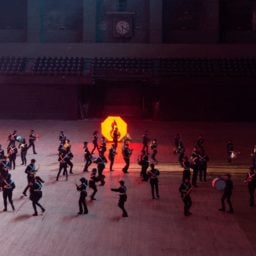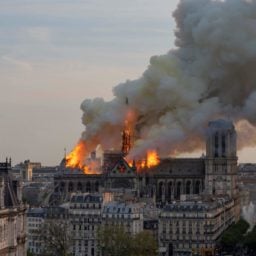Long an “artist’s artist,” the late Gretchen Bender (1951-2004) very much seems like a figure whose moment has come. Her brainy ‘80s-era photo appropriation works and innovative multichannel videos—currently surveyed in “So Much Deathless,” a big retrospective at Red Bull Arts New York—read today as being about an atmosphere of information overload that is pervasive (and pervasively commented upon).
In an interview with my colleague Taylor Dafoe, curator Max Wolf spoke about how he thinks Bender’s work may at last find its audience with “the smartphone generation of kids who are fluent with the ways and velocity with which we consume imagery.” That’s a nice hook. There’s definitely something to the idea that history has finally caught up with Bender.
But this framing also, in a crucial way, leaves something out—something that actually is essential to what makes Bender’s way of thinking about media art particularly interesting, and particularly challenging.
Seeing her work framed by the Red Bull logo here, you can’t help but think of her 1987 interview with friend and collaborator Cindy Sherman in Bomb. Sherman began by asking Bender what she would think of working with corporations, given how much her work was aimed at scrutinizing corporate power.
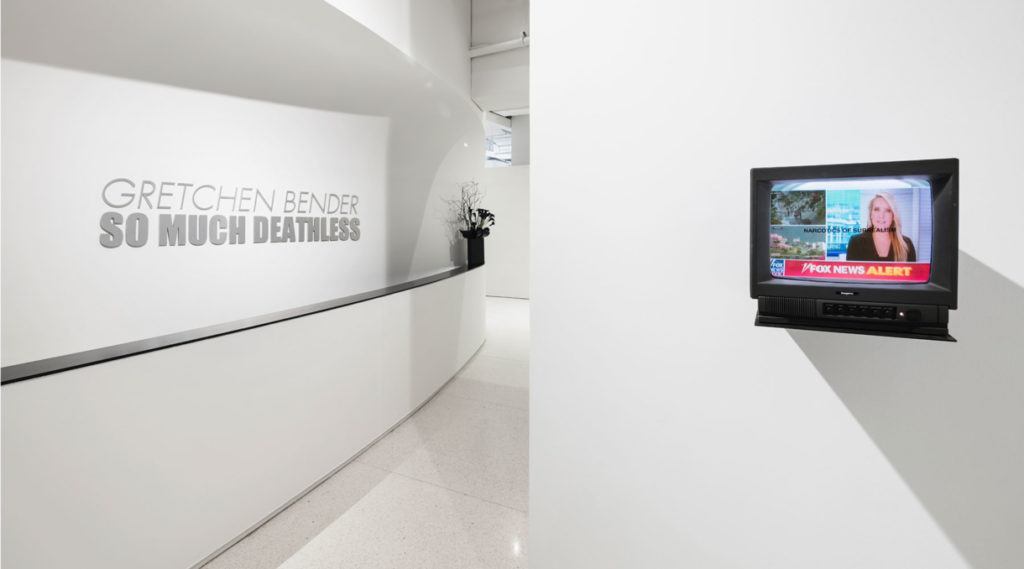
Installation view of Gretchen Bender, Untitled (Narcotics of Surrealism) (1986) in “Gretchen Bender: So Much Deathless” at Red Bull Arts New York, 2019. Image © Gretchen Bender Estate.
“I think, basically, that by the time a corporation has decided to buy my work, that it is a carcass,” Bender replied. “The effectiveness of the work has already left it and only the structure remains. It’s already been neutralized.”
Thinking of herself as half-artist, half-guerrilla media critic, Bender was very, very concerned with theorizing the now-ness of the image, the sense of urgency and relevance that is the flip side of rapid obsolescence and transience. Doing justice to her work seems to me to mean understanding how these qualities shaped its conception then, and its reception now.
Anatomy of a Carcass
“So Much Deathless” is a nicely researched show, featuring, among other things, fresh oral history interviews with Bender’s collaborators and friends. Its centerpiece is a restored version of her most developed work, the installation Total Recall, originally staged at the Kitchen the same year as that Sherman interview. It’s worth the trip all by itself, and it’s what I am going to focus on here.
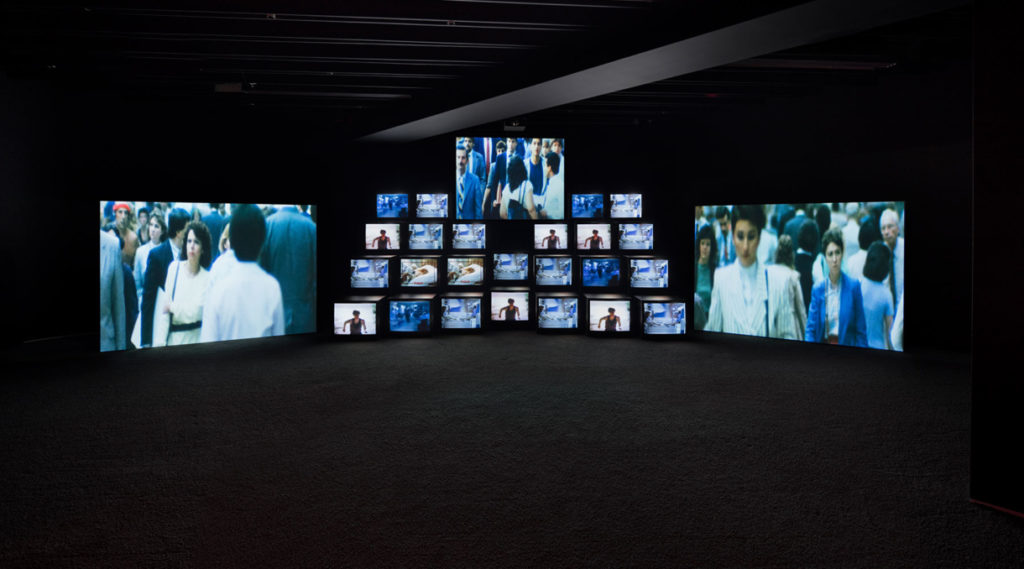
Gretchen Bender, Total Recall (1987) on view in “Gretchen Bender: So Much Deathless” at Red Bull Arts New York, 2019. Image © Gretchen Bender Estate.
Bender called this type of work “Electronic Theater.” As it begins, a disembodied voice speaks into the darkness: “I think I can learn to live with what has happened. The pain will go away to a big degree. But there will always be moments when I’ll stop and think and the pain will start to creep back in. Then I can move on with my life and the pain will slide away again.”
So right at the top, the fragmented barrage of images that is about to hit you from the work’s pyramid of chunky monitors is presented as something like thoughts circling some nameless, traumatic event; a mind jumping around, trying to distract itself but continuously finding echoes of a sinister reality in the entertainment, before flipping the channel again, only to have the bad associations return.
When the monitors kick in, they at first are coordinated. You see looming corporate logos, 3-D animations of globes and wheeling planes, snippets of comfortingly bucolic imagery from commercials: laughing couples, smiling neighbors, a woman on horseback.
A disjointed but operatic electronic-music soundtrack (composed by Stuart Argabright) moves in and out of sync with the flow of strobing imagery. Quickly, the footage of happy people is punctuated by a piercing squeal and all the screens are taken over by jittery abstract flares—the nameless “pain” erupting through the flow of entertainment.
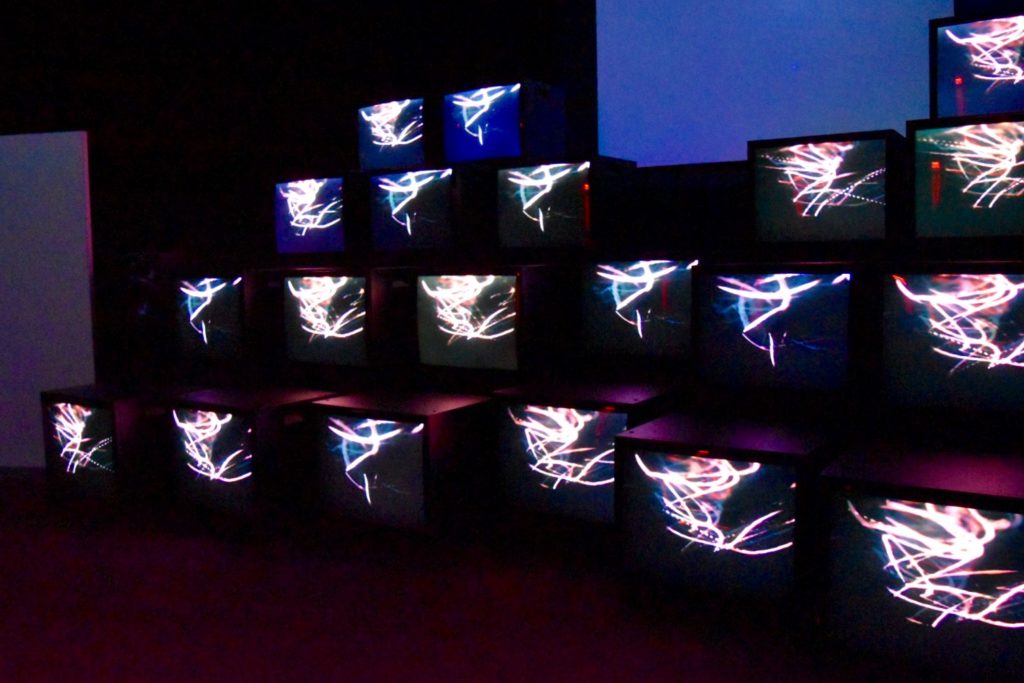
Detail of Gretchen Bender, Total Recall (1987). Image courtesy Ben Davis.
Soon flowers are opening in unison across the monitors—but now the screens begin to show different kinds of flowers, and the installation itself blossoms into different, fragmented channels. Individual images split in half between blossoms and sinister digital starbursts; between comforting stereotypes of natural beauty and high-tech artifice.
The bank of monitors is flanked by large projections that snap on about midway through. Footage of crowds in the streets and escalators frame the pulsating flow of images with flows of people, as if the two were governed by the same code.
As the 19-minute experience goes on, Total Recall is taken over by 1980s ads for the US military, its multitude of displays filling up with jet fighters, sword-wielding Marines, rocket launchers, thundering tanks, and so on. It ends with a clip of a photographer looking through his viewfinder—cypher for the individual relating to the world through the image.
It’s hard exactly to convey the texture or impact of all this, but it is certainly one of the most effective and affecting video installations I’ve seen.
Between Criticism and Anti-Criticism
Bender’s critical bona fides are clear. As Hunter Braithwaite tells it in an informative essay for the show, she cut her teeth leading a Marxist-feminist silkscreen collective, P Street Paperworks, in Washington, DC. Moving to New York in 1978, she found a sympathetic community in the scrappy, appropriation-minded feminist art scene of the time.
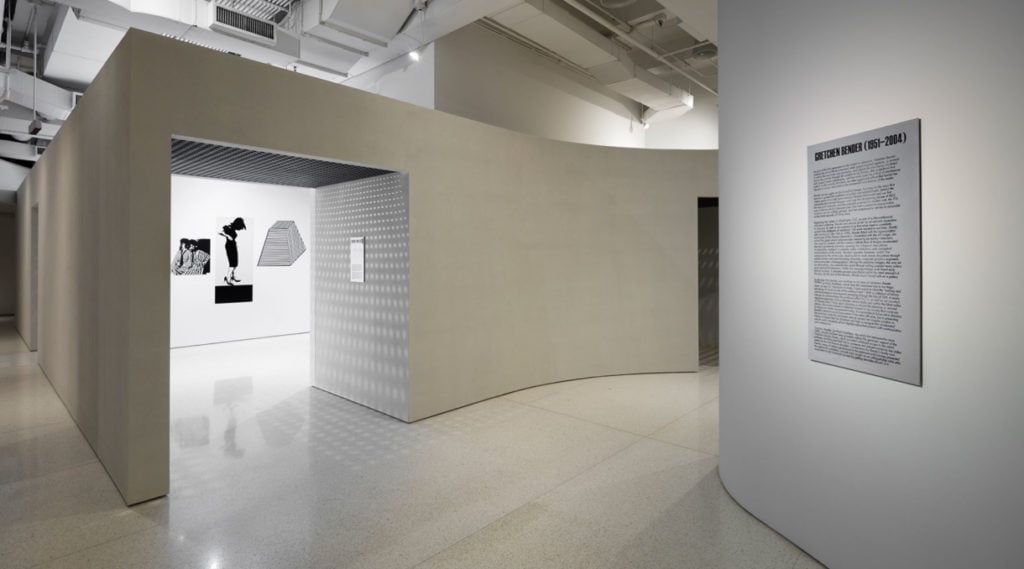
Installation view of “Gretchen Bender: So Much Deathless” at Red Bull Arts New York, 2019. Image © Gretchen Bender Estate.
She showed with people like Jenny Holzer, Barbara Kruger, Louise Lawler, Sherrie Levine, Cindy Sherman, and Laurie Simmons, among others. Those artists were committed to using the tools of art as a counter-public sphere, attacking both the sexism and materialism of the art world and the chauvinism and consumerism of mainstream media.
And yet, by the time of Total Recall, a full decade had passed since the 1977 “Pictures” show had made appropriation of found images a hot topic in art. An altogether more ambiguous position with regard to media was in the air. The autumn of 1986, Peter Schjeldahl wrote, was the season of “Simulationism,” a now-obscure current of thinking loosely inspired by the apocalyptic media theory of Jean Baudrillard (though the French thinker would disavow his influence on art later).
The Simulationist label was attached to artists like Jeff Koons and Peter Halley, who came on the scene proffering the idea that distance from commercial intent was a falsely comforting fiction, and that instead you should embrace the look and aesthetics of commodification without the pretension of critical commentary. As Schjeldahl put it at the time, Simulationism “assimilates end-of-originality and antiexpressionist deconstructions, then zaps them by turning their own skeptical ray against their lurking political sentimentality.”
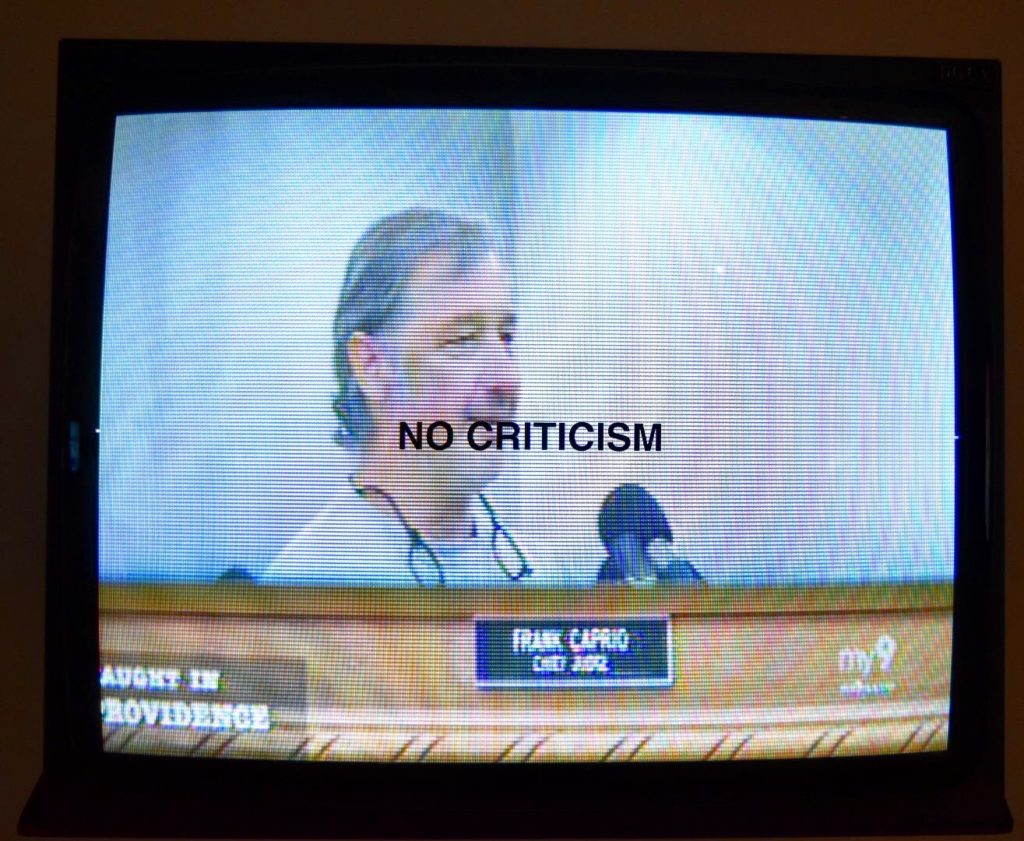
Detail from Gretchen Bender, Aggressive Witness – Active Participant (1990). Image courtesy Ben Davis.
There is a persuasive argument that Bender was not really a “Pictures Generation” artist like Sherman, Levine, or Lawler, but a “post-Pictures” or “post-appropriation” artist. Her work, obviously, was loaded up with critical intensity. But practically, she was operating somewhere between the critique of the media and the critique of the critique of the media—because at the same time that she was making art about the media’s ability to manipulate desire, she also actually had a toe in at the apex of the ‘80s corporate media-industry avant-garde: MTV.
Bizarre Love Triangle
With her boyfriend and collaborator Robert Longo, Bender would help create three pioneering music videos: Megadeth’s Peace Sells and New Order’s Bizarre Love Triangle in 1986, and R.E.M.’s The One I Love in 1987. In each case, Longo directed and Bender edited. The clips are credited with introducing a sophisticated and arty style to MTV, getting away from the use of image simply to illustrate the music, pushing towards abstract and dreamlike associations.
If you watch them now, you will be struck by how much the hyper-driven cutting and the visual tropes—sinister images of the military in Peace Sells, digital graphics, carnivals, fireworks, and urban crowd-flows in Bizarre Love Triangle, time-lapse blossoms and fireworks (again) in The One I Love—seem to prefigure the motifs of Total Recall. (Oddly, the one music video that Bender both edited and directed, Babes in Toyland’s riot grrrl anthem Bruise Violet from 1992, is the one that looks least like her video works.)
In a much-repeated line from her interview with Sherman, Bender spoke of “the media as a cannibalistic river. A flow or current that absorbs everything.” In 1988, the year after Total Recall, Bender would herself cannibalize the same high-impact, paranoid style to create the opening title credits for America’s Most Wanted. Helping to define the genre of “tabloid TV,” the show represented the kind of synthesis between the entertainment industry and the powers of the state that would otherwise have seemed ripe for her critical dissection.
Practically, Bender thought you had to know the media from the inside in order to critique its language. Still, taken one way, her line about how the media “absorbs everything” can go from being a critical insight to being an alibi, as if there could be no tenable distinction between personal intervention and hackwork. (She would profess herself uncomfortable with the “questionable propaganda” of her more mercenary assignments, though she also said she was always looking for a way to subvert from within.)
Artistically, the resistance-is-futile position also leaves the problem that all you can do is to re-assert, over and over again, that there’s nothing to do but wallow in a condition of meaning-sapping emptiness—a position that, in the form of “Simulationism,” was itself already becoming a cliché by the time she made Total Recall.
But Bender had more to say than that, and Total Recall seems about more than luxuriating in fascinating despair. One of the clues is right there in the title.
The Future of the Present
The name Total Recall is evocative of the themes of memory and media overload suggested by the piece—but it is also the name of the Arnold Schwarzenegger film of the same name, which was in production but wouldn’t come out until 1990. At one point during the installation, Bender’s monitors suddenly go black to flash the names of films that were also scheduled to debut in 1987: “Predator,” “Ishtar,” “Shy People,” “Dragnet,” “Batteries Not Included,” etc.
This was a device that Bender used elsewhere (we see it here in the much less satisfying text piece People in Pain, from ’88). She spoke of trying to explore the “anticipatory quality” of media before it arrives—before it becomes added to the big media image bank available for appropriation and collage.
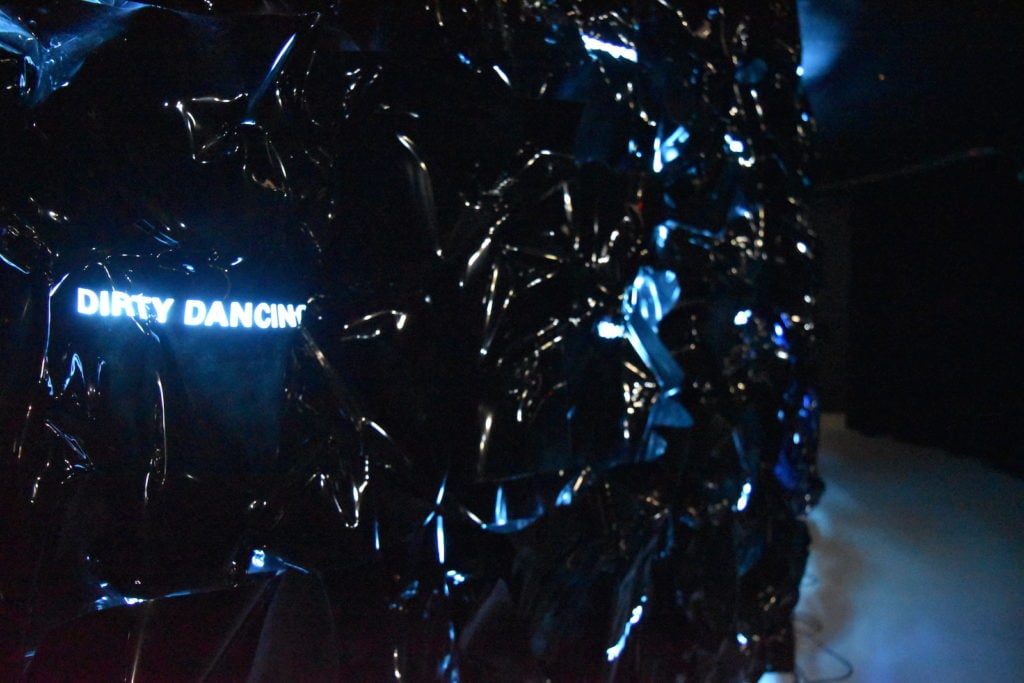
Detail of Gretchen Bender, People in Pain (1988), an installation that lists the names of then-upcoming films, at Red Bull Arts. Image courtesy Ben Davis.
From the point of view of today, I know that Predator spawned many bad sequels, that Ishtar is a legendary flop with a cult audience, and that Shy People is pretty much forgotten. But here they flicker on the same neutral plane. This serves as a time stamp on the work.
Which is to say that, in terms of Total Recall’s transformation into a “carcass,” Bender was an active participant in its mortification. She was deliberately dating her piece.
Generating this sense of bounded historical location was important for Bender’s theory of media criticism. She was working against the way that art that focuses on media overload tends to emphasize and even naturalize the anti-historic, decontextualized quality of images. In fact, the theme of “media overload” itself easily becomes a critical crutch, abstracted from any particular kind of thought about the dynamics of any specific media, a way of not thinking about the present while pretending to think about it.
Real Recall
Here’s a concrete example: Total Recall opens by dwelling on images of ads for General Electric, and the company’s then-famous slogan “We Bring Good Things to Life.”
Bender had noticed GE and other corporations amplifying the zeitgeist of Reaganism by evoking rustic imagery of a mythic America, which is what all the beaming families and women on horseback in the installation are about. At the same time, GE had only just purchased NBC in 1986. GE also happened to be an immensely important weapons and aerospace contractor.
So the GE reference contained layers of associations, about the collision of propaganda, entertainment, and military industrial complex in that late Cold War moment.
Another clip in Total Recall comes from the 1986 Oliver Stone film Salvador, about a photojournalist navigating the horrors of the US’s ghoulish foreign policy in Central America. James Woods and John Savage are pictured as two war photographers, walking through a field of corpses.
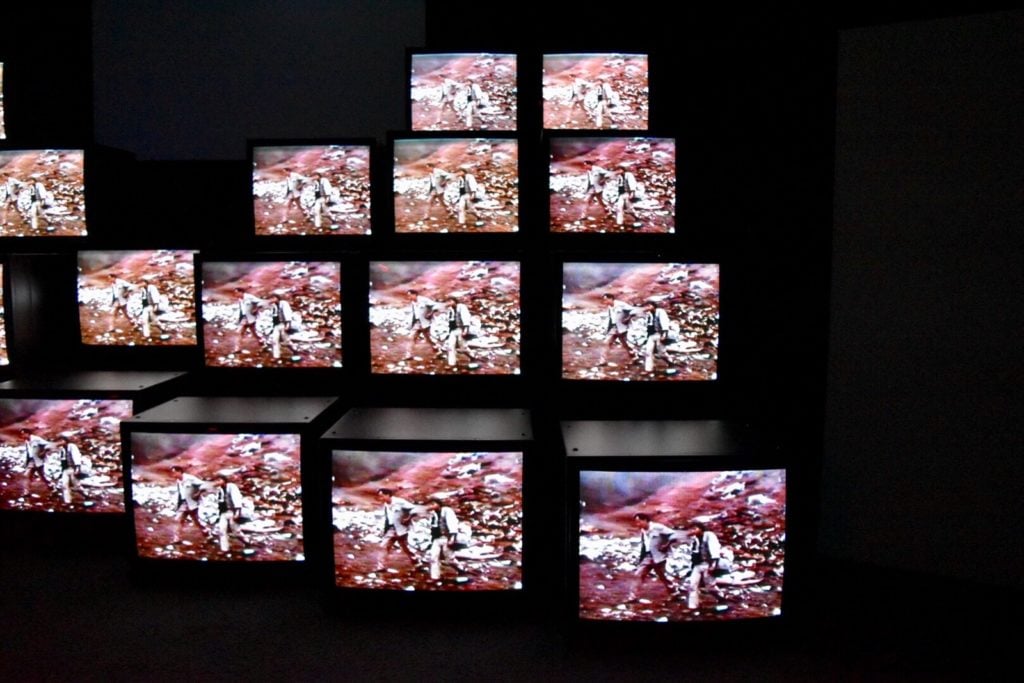
Detail of Gretchen Bender, Total Recall (1987), showing an appropriated clip from Salvador. Image courtesy Ben Davis.
The slowed-down, repeated clip keeps you from seeing what is going on too specifically. To its contemporaneous art audience, its content presumably would have been recognized easily (Woods was nominated for a “best actor” Oscar for the role). The audience may even have seen it as encoding a rumination on the media’s ambiguous relationship to images of violence and death. (“You gotta get close, Rich, to get the truth,” Savage’s photographer is telling Woods, if you track down the clip Bender has appropriated. “You get too close, you die. Some day I want a shot like [Robert] Capa.”)
Cut to the present: General Electric, today, is a humbled giant. It sold off the last of its media holdings in 2013. After more than a century, the once-iconic industrial conglomerate was dropped from the Dow Jones Industrial Average last year, to be replaced by Walgreens.
On the other hand, James Woods has become a new kind of star on Twitter, noted for conspiracy mongering. Media Matters has described him as the “main conduit for content from the far-right fever swamps to millions on Twitter.”
The symbolism has shifted. The entire setup of power and influence is not just different, but unrecognizable, to that experienced by the “smartphone generation.”
Two Meanings
“I think,” Bender told Sherman, “that the time limit to media-oriented artwork is an element that many media involved artists are unwilling to confront: art as I practice it or develop my ideas or aesthetics, has to do with a temporal limit to its meaningfulness in the culture—and that’s real tough.”
It’s worth being as tough as she is. If we are honest about Total Recall, we might even admit that in some way the concussive beauty of the installation is at odds with its original critical intent.
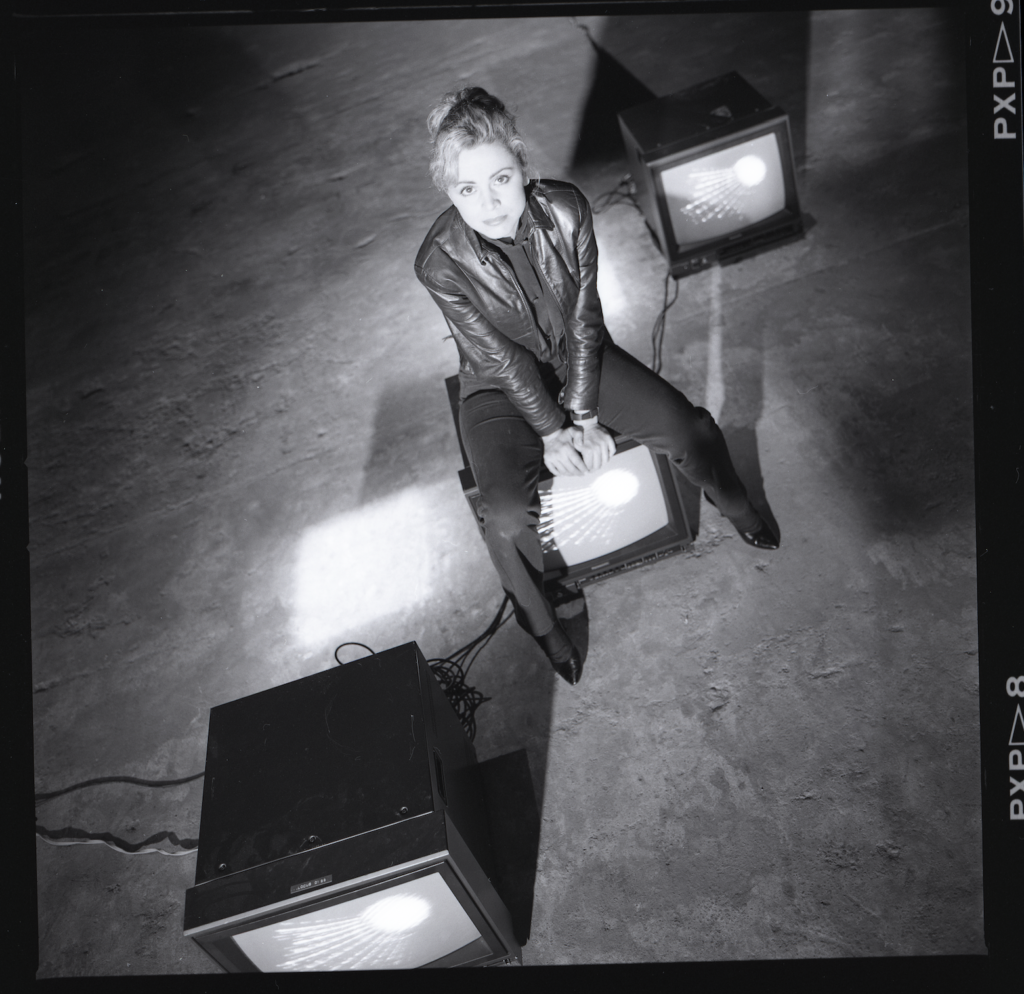
Gretchen Bender, 1986. Courtesy of Red Bull Arts New York. © Hans Neleman.
Then, it was a symbol of sublime, circuit-frying media power—and a sense of acceleration beyond the known speed limit was part of Bender’s strategy of shock and confrontation.
Now, it reads almost as a symbol of the opposite, of the comforting power of a single artist to turn the media to her ends; a distillation of a past moment when the circuits of power were a little more decodable, when art was a little more available as a coping mechanism for that psychic “pain” and dislocation that the installation alludes to.
Even at its first showing, I would say, Total Recall was balanced on the knife’s edge between the two meanings—which was part of its craft. Today, I think, one of the insights of Bender’s work might actually be that its beauty should be viewed as a kind of afterimage of its original critical radiance.
“Gretchen Bender: So Much Deathless” is on view at Red Bull Arts New York, 220 West 18th Street, through July 28, 2019.












